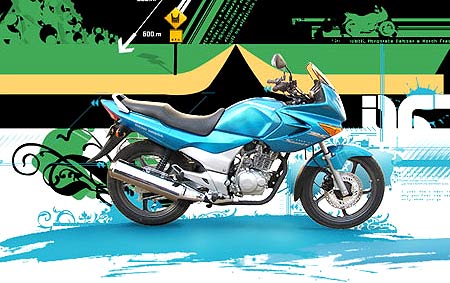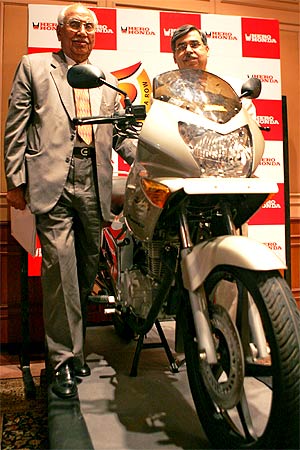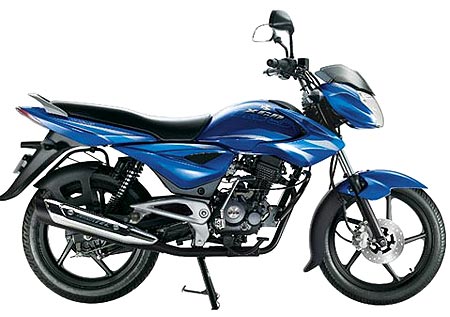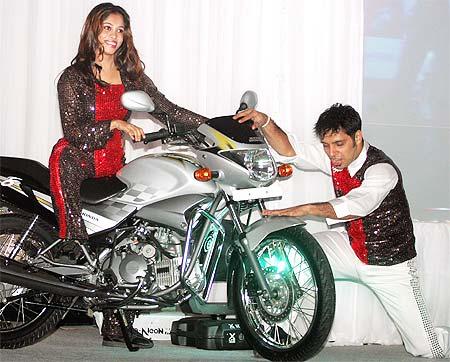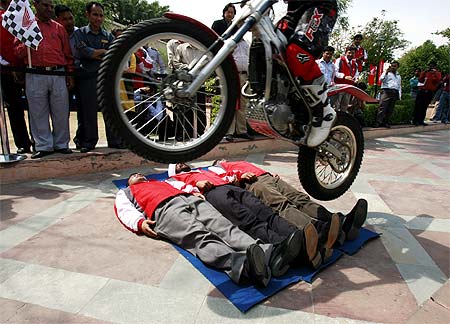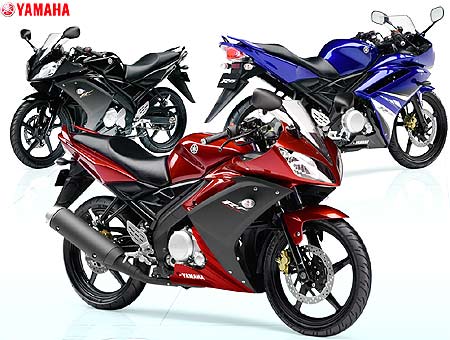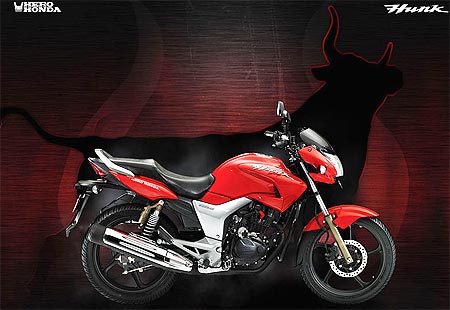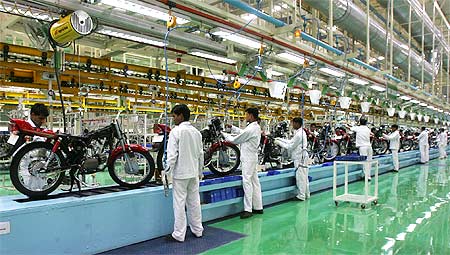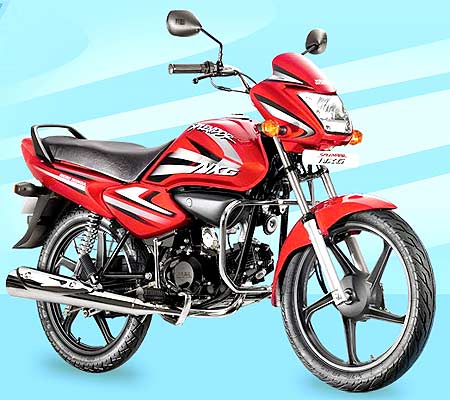 | « Back to article | Print this article |
Will Hero Honda remain the leader?
The ride so far has been a smooth one. But to protect market share, Hero Honda will need to have a bigger presence in the executive segment.
If ever a company had the ability to continuously surprise investors, it's Hero Honda.
Time and again, over the years, skeptics have questioned the company's ability to hold on to its lead motorcycle market.
Doubts have also been voiced over its ability to access technology from its joint venture partner Honda Motors. And the ability to compete with the Japanese major.
Today, the Rs 12,357 crore (Rs 123.57 billion) Hero Honda commands a 57 per cent share in the motorcycle market, in which half a dozen players are slugging it out, including Japanese multinationals, Suzuki and Yamaha.
In an extremely tough 2008-09, Hero Honda managed to sell higher volumes up 12 per cent in the process growing its net profit by 32 per cent. In 2008, the stock made it to the list of the top three Sensex scrips, together with Hindustan Unilever and Glaxo.
Will Hero Honda remain the leader?
Now, with a phenomenal 29.5 per cent year-on-year volume growth in April, Hero Honda has kicked off 2009-10 on a strong note the firm sold 3.70 lakh (370,000) vehicles of which roughly 3.55 lakh (355,000) would have been motorcycles and the rest scooters.
In March, the company had sold 3.53 lakh (353,000) two-wheelers. Having beaten the downturn, Managing Director and CEO Pawan Munjal, is circumspect about the environment in the current year. The next couple of quarters, he says, should be fine though he adds that there isnt too much visibility thereafter.
Nevertheless, Hero Honda is gearing up to meet the competition. Anil Dua, senior vice-president (marketing and sales), says the firm has nine launches lined up across segments.
These include both new models and variants the first of which will hit the market sometime in September just before the festive season.
We will refresh and re-launch our models across the range with new technology, colours, styling and features, says Dua, who refuses to disclose which segments will see more rollouts.
Will Hero Honda remain the leader?
Says Dua, "We plan not to give customer discounts but to spend more on thematic branding, advertising and below the line activity. That way the brand gets a push and the dealer clocks higher volumes and makes more money. We believe a consumer who's paying Rs 40,000 won t mind paying a little more."
Leveraging the portfolio
Since Hero Honda has access to superior technology from its joint venture partner Honda Motors, it can afford to focus more on manufacturing and distribution.
Brands such as Splendour and Passion Plus (100cc), Super Splendour and Glamour (125cc) have held their own in a market where competition is fierce and new launches are frequent. While not all Hero Hondas models have been successes, some of its bestselling models have survived the competition even after all these years.
Will Hero Honda remain the leader?
The recently introduced XCD 135 cc though seems to be a winner; the XCD 125 cc launched earlier failed to take off. TVS Motors has a bestseller in the 150 cc Apache and could have done well with the 100 cc Victor, but the Chennai-based firm failed to come up with saleable models and has only lost market share in the past three years.
Talking of Hero Honda, a Merrill Lynch report says, 'We expect the company to hold on to its market share over the next 12 months following the success of the 100cc Passion Pro and the weak franchise of competitors.'
The rural factor
Its brands apart, what has stood Hero Honda in good stead in the current downturn is its strong rural reach -- 40 per cent of revenues come in from rural markets. Since consumers in the hinterland haven t felt the pinch as much as buyers in urban areas have, Hero Honda has been able to push its models in those markets cashing in especially on the wedding and festive seasons.
Will Hero Honda remain the leader?
In any case, it's a fact that a relatively smaller share of Hero Honda's motorcycles are sold through bank loans.
While a couple of years back, 55- 60 per cent of its sales were financed by banks, the share is now down to 25-30 per cent.
Competitor Bajaj Auto, on the other hand, has been badly hit because credit is scarce. Munjal isn't too hopeful that banks will start lending soon.
At a recent press conference, the managing director noted that the recent move by the RBI to lower key interest rates was welcome. However, he added that banks were still refusing to lend and that was impacting two-wheeler sales.
Small may not be beautiful
As it is, the sub-125cc segment, a space vacated by Bajaj Auto, accounts for the bulk of Hero Honda's volumes. The company commands an 80 per cent share of the space which contributes 65 per cent to total volumes in the motorcycle market.
Will Hero Honda remain the leader?
Munjal's response to competition from HMSI has been on expected lines. He says his firm has always faced competition and that HMSI's entry won't be any different. Merrill Lynch believes the entry of HMSI into this space in 2010-11 will impact Bajaj Auto more than Hero Honda. Others, however, feel Hero Honda could lose some share to HMSI.
Executive class is a must
Industry watchers also believe that with disposable incomes and aspirations rising, the 100 cc segment may not grow as fast as the executive segment (125 cc-135 cc).
That space today accounts for about 25-30 per cent of the total motorcycle market or probably less, but could contribute about 34-35 per cent by 2011. So, if Hero Honda is to hold on to market share, it needs to grow meaningfully in the executive space, in which it has a relatively small share.
Will Hero Honda remain the leader?
Analysts point out that in 2011, Hero Honda's share in the sub-125 cc space will start peaking out and it will have to battle Bajaj Auto, HMSI and Yamaha in the 125 cc plus segment.
At one time, Bajaj Auto ruled this space at some point lost its way. Now it appears to have bounced back with the XCD 135 cc, which is clocking volumes of around 20,000 units a month.
Moreover, the Pune-based firm has a few more launches lined up, which should hit the market by September. Hero Honda will also face some keen competition in the premium segment.
However, it has been doing well in this segment, Dua says, it has doubled its volumes over the past two years with the CBZ Xtreme (155 cc) and Karizma (225 cc), both gaining share.
The premium space, which accounts for 10-15 per cent of the market, has been a good hunting ground for Bajaj Autos Pulsar, TVS Motors Apache, HMSIs Unicorn and more recently the Yamahas FX16, which has become extremely popular.
Will Hero Honda remain the leader?
With competition becoming more intense, Hero Honda's volume growth in the current year could taper off to about 7-8 per cent on a high base; in 2008-09, two-wheeler volumes were up 12 per cent helped by excise duty cuts that the company passed on to customers.
Unless the macroeconomic environment improves and interest rates on two-wheeler loans drop further, it's unlikely the two-wheeler industry will grow by more than 5-6 per cent this year. More than launches from the competition, what could adversely impact Hero Honda's volumes, is any weakness in the demand from the rural areas.
With volumes for Hero Honda estimated to come in at high single digits, revenues this year are expected to go up by about 13-14 per cent to around Rs 14,000 crore (Rs 140 billion). In 2008-09, a difficult year, sales had risen by a strong 20 per cent.
Will Hero Honda remain the leader?
As Munjal has indicated, raw material prices, especially for steel and aluminium, are easing and the company should feel the full benefits this year.
Analysts believe that the lower input costs could push up the EBITDA (earnings before interest tax and depreciation) margin to around 15 per cent compared with the 14.2 per cent posted last year. The margin per bike for Hero Honda is estimated to be somewhere in the region of Rs 5,400 and should be easily maintained, if not improved, in an easier commodity price environment.
At the net profit level, a higher level of production at the Haridwar plant will give the company a bigger tax break. The managing director has indicated that about one million units could be produced at Haridwar this year.
While net profits in 2008-09 at Rs 1,282 crore (Rs 12.82 billion), saw an increase of 34 per cent, the bottom line this year is expected to be in the region of Rs 1,650-1,700 crore (Rs 16.50-17 billion), an increase of about 30 per cent.
Will Hero Honda remain the leader?
After the outperformance in 2008, the stock has run up by a huge 46 per cent since January 2009; Bajaj Auto, of course, saw a sharper rise of 56 per cent. At the current price of Rs 1,184, Hero Honda trades at around 14 times estimated 2009-10 earnings and much of the upside seems to be priced in.
- Hero Honda commands an 80 per cent share of the entry segment, the biggest chunk of the market
- A strong rural presence has helped it beat the downturn
- Its sales are less dependent on finance schemes compared with that for its rivals
- HMSIs entry into the 100cc space could hurt Hero Honda's volumes and market share
- Hero Honda has a relatively small presence in the executive space
- A shift by consumers to the executive space will hurt Hero Honda
- Near-term earnings will be boosted by tax breaks and lower input costs
